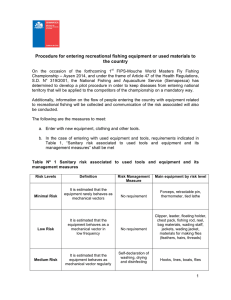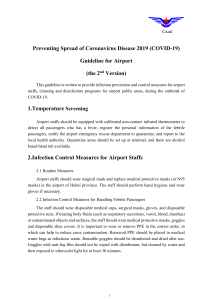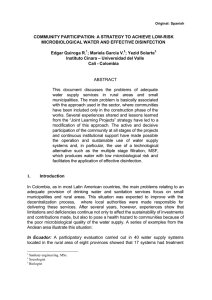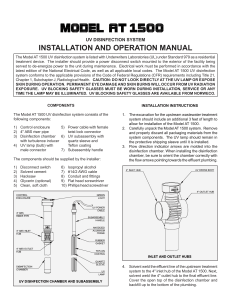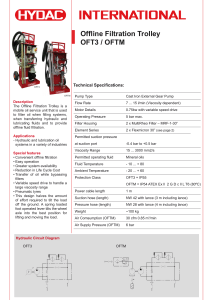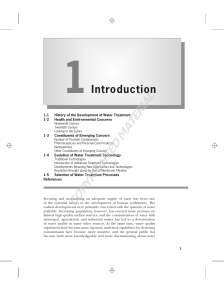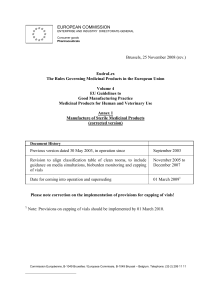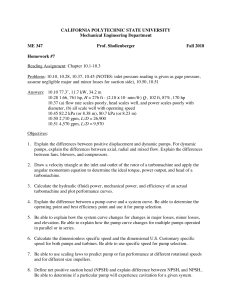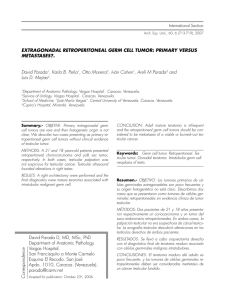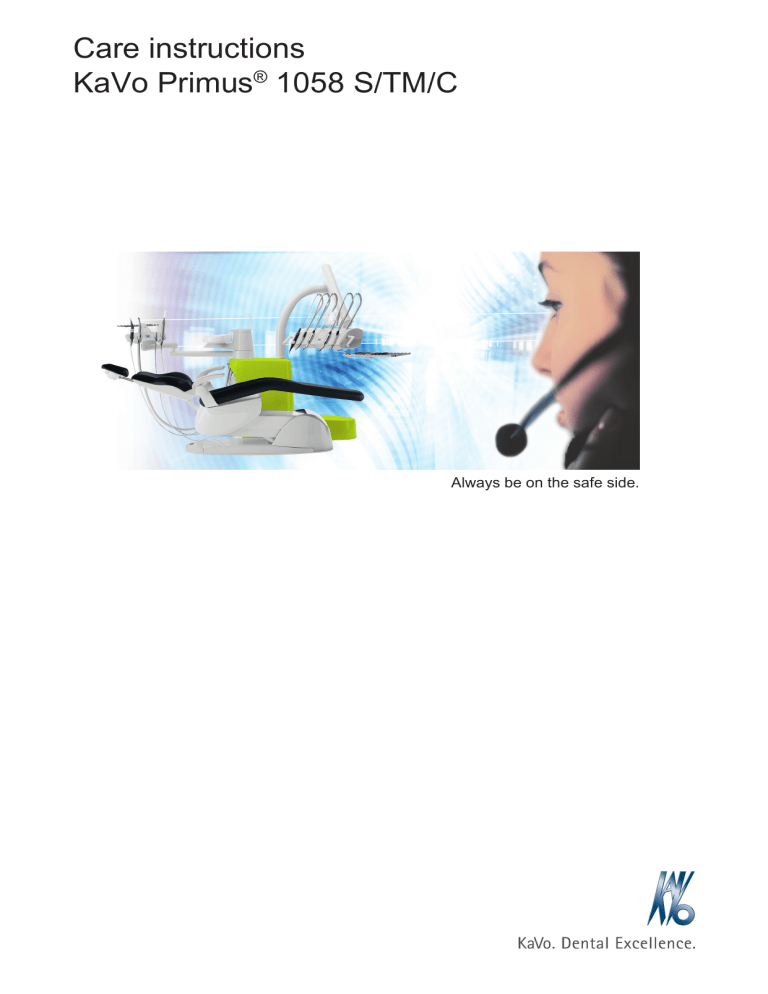
Care instructions KaVo Primus® 1058 S/TM/C Always be on the safe side. Distributed by: KaVo Dental GmbH Bismarckring 39 D-88400 Biberach Phone +49 (0) 7351 56-0 Fax +49 (0) 7351 56-1488 Manufacturer: Kaltenbach & Voigt GmbH Bismarckring 39 D-88400 Biberach www.kavo.com Care instructions KaVo Primus® 1058 S/TM/C Contents Contents 1 2 3 User instructions ........................................................................................................................................ 2 1.1 User guide ....................................................................................................................................... 2 1.1.1 Abbreviations ...................................................................................................................... 2 1.1.2 Symbols .............................................................................................................................. 2 1.1.3 Target group ....................................................................................................................... 2 Setup methods according to DIN EN ISO 17664 ...................................................................................... 3 2.1 References ...................................................................................................................................... 3 2.2 General instructions for the reprocessing of KaVo treatment units ................................................. 4 2.2.1 Reprocessing overview Primus® 1058 S/TM/C .................................................................. 5 2.3 Reprocessing of the surfaces of treatment unit / upholstery ........................................................... 6 2.4 Preparation of the dentist unit ......................................................................................................... 8 2.4.1 Reprocessing of holder pad/anti-slip mat ........................................................................... 8 2.4.2 Reprocessing of handle ...................................................................................................... 8 2.4.3 Reprocessing of the instrument holder (TM table / cart) .................................................. 10 2.4.4 Setting up the triple-function and multifunctional handpiece ............................................ 11 2.4.5 Preparation of the instrument hoses ................................................................................ 14 2.4.6 Servicing the turbine return air filter ................................................................................. 15 2.4.7 Reprocessing of the kit for physiological saline solution (optional) .................................. 15 2.5 Reprocessing of the assistant unit ................................................................................................ 16 2.5.1 Cleaning and disinfection of assistant element ................................................................ 16 2.5.2 Sterilisation assistant element .......................................................................................... 17 2.5.3 Preparing the connector for the suction hose ................................................................... 17 2.5.4 Reprocessing of sieve inserts and suction hoses ............................................................ 18 2.6 Preparation of the patient unit ....................................................................................................... 18 2.6.1 Preparation of the tumbler ................................................................................................ 18 2.6.2 Preparation of the tumbler holder and filler ...................................................................... 19 2.6.3 Preparation of the spittoon ............................................................................................... 20 2.7 Manual reprocessing of the water-conducting system .................................................................. 21 2.8 Automatic hygiene function of the water-conducting system ....................................................... 22 2.8.1 Rinsing program ............................................................................................................... 22 2.8.2 Intensive germ reduction (optional) .................................................................................. 26 2.9 Reprocessing and automatic hygiene functions of the suction system ......................................... 29 2.9.1 Reprocessing the suction system including suction hoses .............................................. 29 2.9.2 HYDROclean function ...................................................................................................... 30 2.10 Preparation of the amalgam separator .......................................................................................... 30 Replenish and check the disinfectant ...................................................................................................... 31 3.1 Replenish OXYGENAL 6 ............................................................................................................... 31 3.1.1 Replenish OXYGENAL 6 when using the water bottle ..................................................... 32 3.2 Check the OXYGENAL 6 concentration ........................................................................................ 35 1/35 Care instructions KaVo Primus® 1058 S/TM/C 1 User instructions | 1.1 User guide 1 User instructions 1.1 User guide Requirement Read these instructions prior to first use to avoid misuse and prevent damage. Note Comply with the Instructions for Use of the Primus® 1058 S/TM/C treatment unit! 1.1.1 Abbreviations Abbre‐ viation IfU CI AI TI SC IEC RI EMC Scaler IR IrDA Explanation Instructions for use Care instructions Assembly instructions Technician's instructions Safety checks International Electrotechnical Commission Repair instructions Electromagnetic compatibility Scaler (ZEG) Infrared Infrared Data Association 1.1.2 Symbols Refer to the chapter on Safety/Warning symbol Important information for users and service technicians Action request CE mark according to EC Directive 93/42 for medical devices Thermodisinfectable at up to 95 °C (203 °F) Suitable for steam sterilisation at up to 135 °C (275 °F) 1.1.3 Target group This document is for dentists and dental office staff. 2/35 Care instructions KaVo Primus® 1058 S/TM/C 2 Setup methods according to DIN EN ISO 17664 | 2.1 References 2 Setup methods according to DIN EN ISO 17664 2.1 References The reprocessing consists of the following basic steps: ▪ Cleaning and disinfection ( manually or automatically) ▪ Sterilisation Note Comply with national hygiene requirements, e.g. RKI guidelines. CAUTION Risk of injury during cleaning of the treatment unit. Lack of instructions to the cleaning staff and lack of preparation of the treatment unit can lead to the cleaning personnel sustaining injuries. ▶ Only trained professionals and instructed cleaning personnel may be present in the treatment rooms. ▶ Position the chair for cleaning and turn the device off. CAUTION Product damage due to improper disinfection. Malfunctions. ▶ Use the disinfectant as prescribed by the manufacturer. ▶ No spray disinfection, perform wipe disinfection only. ▶ Do not immerse product or product parts in liquids. CAUTION Improper disinfection may lead to health hazards and material damage. Infection hazard to users and patients. Damage to the sterile product. ▶ No hot air sterilisation, no chemical cold sterilisation, do not sterilise with eth‐ ylene oxide. CAUTION Health hazard and property damage due to non-compliance with servicing schedule. Infection hazard to users and patients. Product damage. ▶ Comply with servicing schedule. Note The preparation methods for the instruments and motors are found in the sepa‐ rate instructions for use that accompany the instrument and motor packages. 3/35 Care instructions KaVo Primus® 1058 S/TM/C 2 Setup methods according to DIN EN ISO 17664 | 2.2 General instructions for the reprocessing of KaVo treatment units 2.2 General instructions for the reprocessing of KaVo treatment units Please comply with the general reprocessing instructions at all times. Detailed product-specific reprocessing instructions are provided subsequently. At the site of use ▶ Remove any surface contamination using a disposable cloth/paper towel. Storage and transport KaVo recommends reprocessing as soon as possible after use. Preparations for cleaning ▶ Comply with product-specific reprocessing instructions. Manual cleaning Fixtures: ▪ Brush or cloth ▪ Tap water 30 °C ± 5 °C ▶ Rinse surface contamination off the product under running water. Automatic cleaning KaVo recommends thermodesinfection at up to 95 °C in accordance with ISO 15883-1 e.g. Miele G 7781 / G 7881 with the use of a alkaline cleaning agent with a maximum pH value of 10. ▶ For program settings as well as cleansers and disinfectants to be used, please refer to the Instructions for Use of the thermodisinfec‐ tor. ▶ Do not clean instruments and device components in the ultrasound bath. Manual disinfection ▶ Perform wipe disinfection only, the use of spray disinfection and dis‐ infection baths is not feasible. ▶ Wipe all outer surfaces with a soft cloth and an approved disinfec‐ tant. Approved disinfectants: ▪ Microcide AF liquid (Schülke & Mayr) ▪ FD 322 (Dürr) ▪ Incidin Liquid (Ecolab) ▶ Use disinfectants according to the manufacturer's Instructions for Use. ▶ Please note the disinfectant safety data sheet. Automatic disinfection KaVo recommends thermodesinfection at up to 95 °C in accordance with ISO 15883-1 e.g. Miele G 7781 / G 7881 with the use of a alkaline cleaning agent with a maximum pH value of 10. ▶ For program settings as well as cleansers and disinfectants to be used, please refer to the Instructions for Use of the thermodisinfec‐ tor. ▶ Do not disinfect instruments and device components in the ultra‐ sound bath. 4/35 Care instructions KaVo Primus® 1058 S/TM/C 2 Setup methods according to DIN EN ISO 17664 | 2.2 General instructions for the reprocessing of KaVo treatment units Manual drying ▶ Supply dry, clean and uncontaminated compressed air according to ISO 7494-2 only. ▶ Blow off the outside and inside with compressed air until water drops are no longer visible. Automatic drying Automatic drying usually is part of the cleaning/disinfection cycle of the thermodisinfector and should not be carried out above 95 °C. Service ▶ Discard damaged products. Control and functional checks ▶ Perform a visual inspection checking for damage and wear and tear. ▶ Test products for function regularly. Packaging ▶ Use standardised packaging material. Sealing should not be under tension. ▶ Use sterile goods packaging in order to ensure sterility. Sterilisation All sterilisable products are temperature resistant up to max. 138 °C. KaVo recommends sterilisation in a steam steriliser (autoclave) accord‐ ing to EN 13060 / ISO 17665-1, e.g. STERIclave B 2200 / 2200 P (Ka‐ Vo) or Citomat K-Series (Getinge). ▶ Sterilise with a triple fractionated vacuum (B class steriliser); hold for 4 minutes; 134°C ± 1 °C; overpressure: 2.13 bar. Storage ▶ Reprocessed products should be stored protected from dust with minimum exposure to germs in a dry, dark and cool place. ▶ Comply with the expiry date of the sterilised items. 2.2.1 Reprocessing overview Primus® 1058 S/TM/C Reprocessing items/medical devi‐ Cleaning ces manual Surfaces Unit X Disinfection automatic manual Sterilisation automatic automatic X Cushion X Gripping sleeve, white X X X X Gripping sleeve, grey X X X X Lamp and reflector X X Dentist element Handpiece sleeve 3F and MF handpieces Cannula 3F and MF handpiece X X X X X X Holder pad/anti-slip mat X Handpiece holder X X X X X Assistant element 5/35 X X X Care instructions KaVo Primus® 1058 S/TM/C 2 Setup methods according to DIN EN ISO 17664 | 2.3 Reprocessing of the surfaces of treatment unit / upholstery Reprocessing items/medical devi‐ Cleaning ces Connection parts of the suction X hose Patient element Tumbler support X Disinfection X Tumbler filler X X X X Porcelain spittoon bowl X X X X X Sterilisation X X 2.3 Reprocessing of the surfaces of treatment unit / upholstery Position the chair for cleaning ▶ Adjust the backrest to vertical position and move the chair upward. See also: Instructions for usePrimus® 1058 S/TM/C Turn device off ▶ Turn off the main switch to the device. Cleaning and disinfecting the surfaces of treatment unit / upholstery CAUTION Non-colour-fast textiles. Non-colour-fast textiles can cause permanent discoloration. ▶ Remove discolourations with water immediately. 6/35 Care instructions KaVo Primus® 1058 S/TM/C 2 Setup methods according to DIN EN ISO 17664 | 2.3 Reprocessing of the surfaces of treatment unit / upholstery Approved disinfectants: ▪ Microcide AF liquid (Schülke & Mayr) ▪ FD 322 (Dürr) ▪ Incidin Liquid (Ecolab) ▶ Clean the surfaces and upholstery with a soft cloth and water, and wipe-disin‐ fect them with an approved surface disinfectant. CAUTION Damage caused by spray disinfection. Disinfectant gets into cracks and loosens the paint. ▶ No spray disinfection. ▶ Only disinfect by wiping. Cleaning and disinfection of the foot control CAUTION Damage caused by inappropriate use of water. Damage to the foot control. ▶ For cleaning, the foot control must not be immersed in water or placed under running water. ▶ When wiping it off with a moist cloth, do not touch the contacts of the charge socket. ▶ Only wipe off. Do not spray. 7/35 Care instructions KaVo Primus® 1058 S/TM/C 2 Setup methods according to DIN EN ISO 17664 | 2.4 Preparation of the dentist unit 2.4 Preparation of the dentist unit 2.4.1 Reprocessing of holder pad/anti-slip mat Cleaning, disinfection, and sterilisation of holder pad/anti-slip mat Note The holder pads and anti-slip mats on the dentist unit can be removed for better cleaning. ▶ Sterilise the holder pad and anti-slip mat by thermodisinfection. 2.4.2 Reprocessing of handle Cleaning and disinfection of the handle (TM table / cart) Note The handle of the TM table cannot be detached. 8/35 Care instructions KaVo Primus® 1058 S/TM/C 2 Setup methods according to DIN EN ISO 17664 | 2.4 Preparation of the dentist unit CAUTION Damage caused by thermodisinfection. ▶ Do not thermodisinfect the handle of the TM table / cart. F1 F2 ▶ Clean the handle with a soft cloth and water, and wipe-disinfect it with an ap‐ proved surface disinfectant. Sterilisation handle (TM table / cart) CAUTION Damage caused by sterilisation. ▶ Do not sterilise the handle of the TM table / cart. Cleaning and disinfection of the handle (S table) Note The handle on the 1058 S dentist unit is removable for cleaning without a tool. ▶ Press the button on the handle and remove the handle. 9/35 Care instructions KaVo Primus® 1058 S/TM/C 2 Setup methods according to DIN EN ISO 17664 | 2.4 Preparation of the dentist unit ▶ Clean the handle under flowing water. ▶ Disinfect the white and grey handle by wiping or thermodisinfection (minor dis‐ colouration may occur). Sterilisation handle (S table) CAUTION Damage caused by sterilisation. ▶ Do not sterilise the white standard handle. The grey handle (Mat. no. 1.002.4489) can be sterilised (see symbol on the han‐ dle). Note Slight discolouration may occur during sterilisation. 2.4.3 Reprocessing of the instrument holder (TM table / cart) Cleaning and disinfection of the instrument holder CAUTION Damage caused by thermodisinfection. ▶ Do not thermodisinfect the instrument holder. ▶ Pull the snap-in buttons outward evenly and carefully remove the instrument holder. ▶ Clean the instrument holder under running water. ▶ Wipe-disinfect the instrument holder. 10/35 Care instructions KaVo Primus® 1058 S/TM/C 2 Setup methods according to DIN EN ISO 17664 | 2.4 Preparation of the dentist unit Sterilize the instrument holder CAUTION Damage caused by sterilisation. ▶ Do not sterilise the instrument holder. 2.4.4 Setting up the triple-function and multifunctional handpiece Note Wet the O-rings of the sleeves after sterilisation using silicone grease (Mat. no. 1.000.6403) or KaVo Rota Spray 2 (Mat. no. 0.411.7510). After replac‐ ing the cannula, the air channel must be blown out before the start of treatment to ensure that the air exiting during treatment is dry. Cleaning the triple-function and multifunction handpiece Automatic cleaning Not applicable. CAUTION Damage caused by improper cleaning/disinfection. ▶ Do not wash the gripping sleeve and the cannula in the thermodisinfector. ▶ Do not sterilise the gripping sleeve and the cannula in the hot-air steriliser. ▶ Do not place the gripping sleeve and the cannula in a disinfectant or ultra‐ sonic bath. Manual cleaning Note Combine manual cleaning with disinfection. Cleaning the interior ▶ Leave the gripping sleeve and cannula on the instrument, and activate the air and water for 60 seconds. External cleaning CAUTION Danger of injury if the valve body is hot (heating elements, high-pressure lamp). Risk of burn injury. ▶ Switch off the unit at the main switch. ▶ Let the handpiece cool after long use. 11/35 Care instructions KaVo Primus® 1058 S/TM/C 2 Setup methods according to DIN EN ISO 17664 | 2.4 Preparation of the dentist unit Accessories required: ▪ Tap water 30°C ± 5°C ▪ Brush, e.g. medium-hard toothbrush ▶ Disassemble the gripping sleeve and cannula. ▶ Detach the key part from the gripping sleeve. ▶ Clean the key part, gripping sleeve and cannula by brushing them under run‐ ning water (at least tap water quality). ▶ Immediately remove contamination from materials used in the dental practice (impression materials, caustic chemicals). ▶ Carefully wipe off contamination from the cannula tip with a soft Q-tip or soft cloth and alcohol. CAUTION Damage caused by using a nozzle needle that is too long. Damage to the internal hoses of the cannula. ▶ Use a short nozzle needle (Mat. no. 1.004.4986) to clean the media exit holes. ▶ Carefully remove contamination from the media exit ports using the short noz‐ zle cleaning needle. Disinfection of the triple-function and multifunction handpiece Manual disinfection External disinfection ▶ Wipe-disinfect the surfaces with a soft cloth. Automatic disinfection Not applicable. 12/35 Care instructions KaVo Primus® 1058 S/TM/C 2 Setup methods according to DIN EN ISO 17664 | 2.4 Preparation of the dentist unit CAUTION Damage caused by improper cleaning/disinfection. ▶ Do not wash the gripping sleeve and the cannula in the thermodisinfector. ▶ Do not sterilise the gripping sleeve and the cannula in the hot-air steriliser. ▶ Do not place the gripping sleeve and the cannula in a disinfectant or ultra‐ sonic bath. Drying the triple-function and multifunction handpiece Manual drying ▶ Blow off the outside and inside with compressed air until water drops are no longer visible. Automatic drying Not applicable. Servicing the triple-function and multifunctional handpiece Requirement The multifunctional handpiece has been prepared. ▶ Apply KaVo silicone grease (Mat. no. 1.000.6403) or KaVo Rota Spray 2 (Mat. no. 0.411.7510) to the O-rings of the joint between the gripping sleeve and cannula. Use cotton buds for this purpose. Sterilising the triple-function and multifunction handpiece Note The grip sleeve and cannula can be sterilised. 13/35 Care instructions KaVo Primus® 1058 S/TM/C 2 Setup methods according to DIN EN ISO 17664 | 2.4 Preparation of the dentist unit ▶ Hold the handpiece at the taper sleeve and take off the cannula with a slight twisting motion. ▶ Pull the gripping sleeve off the valve body. Sterilization in a steam sterilizer in compliance with DIN EN 13060 ▶ Weld the cannula and grip sleeve in sterile goods packaging. ▶ Sterilise with a triple fractionated vacuum (B class steriliser); hold for 4 mi‐ nutes; 134°C ± 1 °C; overpressure: 2.13 bar. CAUTION Damage caused by over-heating. Damage to the gripping sleeve. ▶ Immediately remove the parts from the steriliser after the sterilisation cycle is completed. Storage ▶ Reprocessed products should be stored protected from dust with minimum ex‐ posure to germs in a dry, dark and cool place. 2.4.5 Preparation of the instrument hoses Cleaning and disinfection of instrument hoses ▶ Clean the hoses and couplings with a cloth and water. CAUTION Damage caused by spray disinfection. ▶ Do not subject instrument hoses to spray disinfection. ▶ Subject instrument hoses to wipe disinfection. 14/35 Care instructions KaVo Primus® 1058 S/TM/C 2 Setup methods according to DIN EN ISO 17664 | 2.4 Preparation of the dentist unit 2.4.6 Servicing the turbine return air filter Cleaning the turbine return air filter Note The liquid collector must be checked weekly. ▶ If liquid is in the filter , drain the liquid and replace the O-rings of the multiflex couplings. ▶ If necessary, replace the turbine return air filter (Mat. no. 0.220.7926) and clean the filter holder. 1058 TM/C/G 1058 S Return air filter 1058 TM/C: Filter 1058 S: Round plate 33 Mat. no. Mat. no. 0.220.7926 Mat. no. 0.200.3098 2.4.7 Reprocessing of the kit for physiological saline solution (op‐ tional) The kit for physiological saline solution is optional. Note The silicone hoses of the kit must be sterilised after each patient. 15/35 Care instructions KaVo Primus® 1058 S/TM/C 2 Setup methods according to DIN EN ISO 17664 | 2.5 Reprocessing of the assistant unit Cleaning the kit for physiological saline solution When using saline solution, all lines conducting the solution must be rinsed direct‐ ly after treating the patient. ▶ Draw the pump hose with the needle from the NaCl bag. ▶ Immerse the pump hose needle in a container with distilled water (min. 150 ml). ▶ Activate the pump, and pump distilled water completely through it. Sterilisation kit for physiological saline solution Note The following parts can be subjected to sterilisation: – Silicone hoses for saline solution and their connecting nipples CAUTION Damage caused by sterilisation. ▶ Do not sterilise instrument hoses and hose clips for saline hose. Requirement The hoses for the physiological saline solution are rinsed. ▶ Seal the motor holder, handpieces, and contra-angle handpieces (and instru‐ ments if applicable) in a sterilisation bag and sterilise them. Note Allow the sterilised items to cool to room temperature before using them again. 2.5 Reprocessing of the assistant unit 2.5.1 Cleaning and disinfection of assistant element ▶ Remove the instruments and suction hoses from the holder. 16/35 Care instructions KaVo Primus® 1058 S/TM/C 2 Setup methods according to DIN EN ISO 17664 | 2.5 Reprocessing of the assistant unit ▶ Clean the assistant element with a soft cloth and a mild, non-abrasive clean‐ ing solution. 2.5.2 Sterilisation assistant element CAUTION Damage caused by sterilisation. ▶ Do not sterilise the assistant element. 2.5.3 Preparing the connector for the suction hose ▶ Remove connectors ① and ② from the suction hoses. Cleaning and disinfection of the suction hose connector ▶ Clean the disassembled parts under running water. ▶ Thermodisinfect the disassembled parts for at least 10 minutes at 93 °C (total cycle: approximately 20 minutes) Sterilising the suction hose connector CAUTION Damage caused by sterilisation. ▶ Do not sterilise the suction hose connector. 17/35 Care instructions KaVo Primus® 1058 S/TM/C 2 Setup methods according to DIN EN ISO 17664 | 2.6 Preparation of the patient unit Note Sterilise the suction cannulas according to the manufacturer's instructions. 2.5.4 Reprocessing of sieve inserts and suction hoses Note Check the sieve inserts daily and after each surgery. The sieve inserts must be replaced at the latest when the suction decreases (Mat. no. 0.763.3423). Cleaning is not recommended for hygienic reasons. ▶ Remove the suction hoses from the holder. The suction motor starts automatically when the suction tubes are removed from the holder. ▶ Hold the cloth under the sieve seat, and pull the sieve insert out of the hous‐ ing. ▶ If needed, insert a new sieve insert (Mat. no. 0.763.3423) into the seat. ▶ Wipe the suction tubes with disinfectant. 2.6 Preparation of the patient unit 2.6.1 Preparation of the tumbler ▶ Reprocess as specified by the manufacturer. 18/35 Care instructions KaVo Primus® 1058 S/TM/C 2 Setup methods according to DIN EN ISO 17664 | 2.6 Preparation of the patient unit 2.6.2 Preparation of the tumbler holder and filler CAUTION Water in the device. Material damage from leaking water upon actuation of the "Tumbler filler" or "Bowl flush" keys. ▶ Make sure that the unit is turned off before removing the tumbler filler or the spittoon bowl. ▶ Always check the correct seating of tumbler filler and spittoon bowl before turning on the unit. Cleaning and disinfection of the tumbler holder and filler Note When assembling, make sure that the O-ring is present on the tumbler filler. Note Inspect the O-ring (Mat. no. 0.200.6128) for damage and exchange if necessary to prevent water or oxidation damage. ▶ ▶ ▶ ▶ Remove the tumbler filler ① (Mat. no. 0.764.8541) by pulling upwards. Take off the tumbler holder ③ (Mat. no. 0.764.6153). Clean the tumbler holder and tumbler filler under running water. Wet the O-ring ② (Mat. no. 0.200.6128) with silicone grease (Mat. no. 1.000.6403). 19/35 Care instructions KaVo Primus® 1058 S/TM/C 2 Setup methods according to DIN EN ISO 17664 | 2.6 Preparation of the patient unit CAUTION Damage caused by thermodisinfection. ▶ Do not subject the tumbler holder to thermodisinfection. The tumbler filler can be subjected to thermodisinfection. Sterilisation of the tumbler holder and filler CAUTION Damage caused by sterilisation. ▶ Do not sterilise the tumbler holder and filler. 2.6.3 Preparation of the spittoon CAUTION Water in the device. Material damage from leaking water upon actuation of the "Tumbler filler" or "Bowl flush" keys. ▶ Make sure that the unit is turned off before removing the tumbler filler or the spittoon bowl. ▶ Always check the correct seating of tumbler filler and spittoon bowl before turning on the unit. Cleaning and disinfection of the spittoon bowl CAUTION Damage caused by inappropriate cleaning agents. ▶ Do not use acid-containing, sand-containing, and form-forming cleaning agents. ▶ Add a dose of DEKASEPTOL gel to the spittoon bowl and distribute the agent with a brush. ▶ For cleaning, allow the gel to act for approx. 5 minutes. ▶ For disinfection, allow the gel to act for approx. 15 minutes. ▶ After letting it work, press the "Spittoon bowl" button. ▶ Clean the spittoon bowl thoroughly using a brush. 20/35 Care instructions KaVo Primus® 1058 S/TM/C 2 Setup methods according to DIN EN ISO 17664 | 2.7 Manual reprocessing of the water-conducting sys‐ tem ▶ For thorough cleaning or thermodisinfection, rotate the spittoon bowl and lift it off. The spittoon bowl made of porcelain can be subjected to thermodisinfection. 2.7 Manual reprocessing of the water-conducting system Note Using the "Water block, compact", a water bottle or the Water block DVGW as‐ sembly kit with integrated germ reducing facility but no intensive germ reduction assembly kit, the water-conducting system must be rinsed manually. The auto‐ matic hygiene functions are available through the intensive germ reduction as‐ sembly kit only. WARNING Risk of infection if the "Water block, compact" is used without additional safe‐ guards. Contamination of the treatment water and/or drinking water supply with germs. ▶ With regard to the "Water block, compact" assembly kit, please note that no disinfection facility is installed in the unit, and take appropriate safeguards. KaVo recommends to use the "Water block DVGW with integrated water dis‐ infection facility in combination with KaVo OXYGENAL 6 (Mat. no. 0.489.3451). ▶ If the Water bottle kit is used with the enclosed dosing attachment (Mat. no. 1.002.0287), add the proper amount of KaVo OXYGENAL 6 (Mat. no. 0.489.3451) with each filling. For the correct amount, please refer to the Instructions of the dosing attachment for water disinfection. Manual reprocessing procedure: ▪ Before first start-up and after the device has not been used for a while (week‐ ends, holidays, vacation times, etc.) ▪ Before you start working ▪ After each patient (short rinsing programme of 20 seconds) ▶ Rinse all water outlets without handpieces for 2 minutes and actuate tumbler filler repeatedly. 21/35 Care instructions KaVo Primus® 1058 S/TM/C 2 Setup methods according to DIN EN ISO 17664 | 2.8 Automatic hygiene function of the water-conducting system ▶ Before first start-up and after the device has not been used for a while, briefly blow air through the air lines. 2.8 Automatic hygiene function of the water-conducting system Note Intensive germ reduction kit and water block DVGW required. CAUTION Health damage due to germ formation. Infection hazard. ▶ Before starting, rinse all the water drain lines without instruments. ▶ Before start-up and after the device has not been used for a while (week‐ ends, holidays, vacations, etc.), rinse or purge with air the air and water lines. ▶ Carry out an intensive germ reduction. ▶ Actuate the tumbler filler repeatedly. The water-conducting system includes all water ducts of the treatment unit to which the patient may be exposed. This includes the handpieces on the dentist element and assistant element as well as the tumbler filler on the spittoon bowl of the treatment centre. During normal operation of the treatment centre, the continuous germ reduction function secures continuous germ reduction in the water conducting systems due to the automatic dosing of the disinfectant, KaVo OXYGENAL 6. The rinsing programme and the intensive germ reduction facilitate the automatic rinsing and germ reduction of the water-conducting system. This counteracts the formation of micro-organisms in times of stagnation and ensures hygienic water supply for the patients. 2.8.1 Rinsing program The rinsing programme provides for automatic rinsing of the water-conducting system and all instruments including the tumbler filler (hydrogen peroxide concen‐ tration 0.02 %). Carry out the rinsing programme: ▪ Before you start working ▪ after every patient ▶ Press the LP/AP button (AP-LEDs flash for 4 seconds). While they are flash‐ ing, press the "Spray preselection" button. 22/35 Care instructions KaVo Primus® 1058 S/TM/C 2 Setup methods according to DIN EN ISO 17664 | 2.8 Automatic hygiene function of the water-conducting system Preparation for rinsing programme and intensive germ reduction ▶ Position the disinfection kit on the porcelain spittoon bowl. Place the instruments on the sterilisation attachment The cannula of the triple-function and multifunctional handpieces must be re‐ moved for the rinsing program and the intensive germ reduction. ▶ Hold the handpiece at the taper sleeve and take off the cannula with a slight twisting motion. 23/35 Care instructions KaVo Primus® 1058 S/TM/C 2 Setup methods according to DIN EN ISO 17664 | 2.8 Automatic hygiene function of the water-conducting system ▶ Insert the triple-function or multifunction handpiece without cannulas into the clamping elements of the disinfection attachment. Make sure that the "W" but‐ ton (water) of the three-function or multifunction handpiece is pressed, and that no air is exiting. ▶ Place the instrument hoses of the dentist and assistant elements in the corre‐ sponding places of the disinfection attachment. Note All water regulation mechanisms for the motor, instruments, and multiflex cou‐ plings must be open. Place the COMFORTbase on the rinsing attachment Note A seat adapter (Mat. no. 1.005.6892) for the rinsing attachment is available for the COMFORTbase. ▶ For the rinsing programme and intensive germ reduction, press the seat adapter into one of the four rubber seats of the rinsing attachment. ▶ Place the COMFORTbase in the seat adapter. Performance of the rinsing program Set rinsing time Requirement Memospeed control element is installed. 24/35 Care instructions KaVo Primus® 1058 S/TM/C 2 Setup methods according to DIN EN ISO 17664 | 2.8 Automatic hygiene function of the water-conducting system M ▶ During the preparation for the rinsing program, press the foot control to set the time for the dental instrument rinsing and the triple-function or multifunction syringe between 0 seconds and 8:30 minutes. T The standard value for the rinsing program is 2:00 minutes per instrument. Adjust the time with the "Chair up" and "Chair down" keys from 00:00 to 8:30 mi‐ nutes. The rinse program has four steps. Step 4.0 3.0 2.0 1.0 0.1 Description Fresh water supply Duration: 60 seconds Tumbler rinsing Duration: 20 seconds Rinsing of the handpieces The rinsing time can be set variably for each instrument The standard setting is 2 minutes per instrument Rinsing the triple-function and multifunction handpiece Duration: set rinsing time of the rinsing programme Waiting position for setting down the handpieces Start rinsing programme Note The rinsing program can be started immediately or the next morning. ▶ Press the "Preselected spray" button. or ▶ Turn off the device and do not restart it until the next morning. The cycle is started automatically. Note If the device is not used the entire day (i.e., the instruments are not mounted), the rinsing program automatically starts the next morning when the device is turned on. Press the "Spray preselection" key to stop the rinsing procedure at any time. If the device is turned off and then on again, the rinsing program also stops. 25/35 Care instructions KaVo Primus® 1058 S/TM/C 2 Setup methods according to DIN EN ISO 17664 | 2.8 Automatic hygiene function of the water-conducting system 2.8.2 Intensive germ reduction (optional) Note Observe the instructions for use for the instruments. Intensive germ reduction prevents the formation of microorganisms during exten‐ ted periods when the equipment is out of use. During intensive germ reduction, the afferent water ducts are automatically filled with a higher concentration of KaVo OXYGENAL 6. The intensive germ reduction program lasts ca. 45 minutes. The increased hydrogen peroxide concentration acts in the system for at least 30 minutes. An additional intensive germ reduction must be carried out during extended peri‐ ods on non-use (> 4 weeks). The requirement for intensive germ reduction is displayed automatically at the first start-up and after periods of non-use (weekends, public holidays, vacation etc.) by flashing of the LED "Motor anticlockwise direction" every 2 seconds. The OXYGENAL must be replenished if you hear a beep signal every 10 seconds Note The suction device cannot be used during the HYDROclean step (4.6). Note If the amalgam separator malfunctions during intensive germ reduction, the en‐ tire process is stopped. Intensive germ reduction must be carried out: ▪ At first start-up ▪ Before, during and after prolonged downtimes (more than 4 weeks) ▪ Over the weekend ▪ During vacations ▪ After treatment of patients at high risk Start intensive germ reduction ▶ Press the "Motor anticlockwise direction" button when the instruments are mounted until you hear an beep and the LED flashes. ▶ Prepare for intensive germ reduction. See also: Preparation for rinsing programme and intensive germ reduction, Page 23 ▶ Press the "Motor anticlockwise direction" button once again. The intensive germ reduction is started. Intensive germ reduction runs in 8 steps: 26/35 Care instructions KaVo Primus® 1058 S/TM/C 2 Setup methods according to DIN EN ISO 17664 | 2.8 Automatic hygiene function of the water-conducting system Step 7.0 6.0 5.0 4.0 3.0 2.0 1.0 0.1 Description Germ reduction of the triple-function and multifunctional handpiece and the spittoon bowl Duration: 60 seconds Disinfection of the handpieces Duration: 30 seconds each Disinfection of the tumbler Duration: 40 seconds Dwell time (acoustic signal, switch off is possible) Duration: 30 minutes Rinsing of the tumbler Duration: 40 seconds Rinsing of the handpieces Duration: 30 seconds Rinsing of the triple-function and multifunctional handpiece Duration: 30 seconds Waiting position for setting down the handpieces After intensive germ reduction is over, the "Device ON" LED and the "Service" LED flash. ▶ Put all handpieces in holders and take off the rinsing attachment. Interrupt intensive germ reduction during the dwell time So that no one will have to remain with the device throughout the entire intensive germ reduction process, intensive germ reduction can be interrupted in program step 4 (e.g. on the last workday before the weekend). Program step 4 is the dwell time, in which the microorganisms are killed by an increased OXYGENAL 6 con‐ centration. Requirement intensive germ reduction is in program step 4. You hear a beep for 4 seconds. ▶ Turn the device off. When the device is switched on after 30 minutes of dwell time, the remaining pro‐ gram steps run immediately and automatically. If the device is turned on before the 30 minute period is elapsed, the dwell times finishes first before the remaining steps of the intensive germ reduction program run. Skip exposure phase This function is required when the treatment unit needs to be used (for example in an emergency, at hospitals, etc.) even though the germ reduction procedure has already started. Requirement The intensive germ reduction is in step 7 to 5 prior to the reaction phase. 27/35 Care instructions KaVo Primus® 1058 S/TM/C 2 Setup methods according to DIN EN ISO 17664 | 2.8 Automatic hygiene function of the water-conducting system M ▶ Press and hold down the "Motor anticlockwise direction" button, the "Tumbler filler" button and the foot pedal simultaneously. T - A beeps sounds. The intensive germ reduction switches to step 3. The automatic rinsing process starts up. ▶ After the rinsing process, set down the instruments. Note The OXYGENAL concentration increases after the interruption of the intensive germ reduction. The automatic rinsing process must run (approximately a 6 mi‐ nutes). Intensive germ reduction during prolonged periods of non-use; 4 weeks During extended periods of non-use, e.g. semester breaks at university, intensive germ reduction must be carried out during the time of non-use. The germ reduc‐ tion fluid remains inside the system during the period of non-use. Before the period of non-use ▶ Start the intensive germ reduction and stop it in step 4 after the signal tone during the dwell time of 30 minutes. ▶ To prevent damage due to hoses getting kinked, remove hoses from the germ reduction attachment and place them in the dentist support. ▶ Keep the germ reduction attachment in the spittoon bowl. ▶ Cover the treatment unit during extended periods of non-use. After the period of non-use ▶ Turn on the central compressor. ▶ Switch on the water supply for the treatment unit after the system pressure is achieved. ▶ Replace the instrument hoses of the dentist and assistant units in the places provided in the germ reduction attachment. ▶ Turn the treatment unit on. The unit automatically starts the remaining steps of the unfinished cycle. 28/35 Care instructions KaVo Primus® 1058 S/TM/C 2 Setup methods according to DIN EN ISO 17664 | 2.9 Reprocessing and automatic hygiene functions of the suction system ▶ Allow the cycle to complete and then carry out a second full intensive germ re‐ duction. The unit is now ready for use. Additional intensive germ reduction during period of non-use KaVo recommends carrying out an additional intensive germ reduction at univer‐ sities during semester breaks. This flushes the parts of the unit and replaces the germ reduction liquid. 2.9 Reprocessing and automatic hygiene functions of the suction system 2.9.1 Reprocessing the suction system including suction hoses Cleaning and disinfection of the suction system including suction hoses Note Clean the suction hoses after each treatment and disinfect them with DEKASEP‐ TOL Gel daily. Application of DEKASEPTOL Gel ▶ Aspirate one tumbler of cold water with each suction hose. ▶ With the suction handpiece attached or by hand, press down the DEKASEPTOL dosing facility once each for the saliva ejector hose and the spray mist ejector. ▶ Aspirate the DEKASEPTOL Gel from the dosing facility. ▶ Aspirate another tumbler of cold water with each suction hose. ▶ Finally, aspirate another dose of DEKASEPTOL Gel and allow it to act. ▶ Place the suction hoses in the holder. DEKASEPTOL Gel basic set Mat. no. 1.000.7204 29/35 DEKASEPTOL Gel refill canister Mat. no. 1.000.7205 Care instructions KaVo Primus® 1058 S/TM/C 2 Setup methods according to DIN EN ISO 17664 | 2.10 Preparation of the amalgam separator 2.9.2 HYDROclean function The HYDROclean function is an automatic programme for hydro-mechanical cleaning of the drainage and separation systems within and outside the treatment unit. The cleaning process is carried out by the supply of fresh, clear water (limi‐ ted rinsing). The water is aspirated from the Aquamat through the filter housing to the separation system. The spittoon bowl rinsing is alternately turned on and off. The HYDROclean function prevents the coagulation and adhesion of proteins in‐ side the drainage system and improves the transporting of fine particles. Carrying out the HYDROclean function: ▪ After each treatment Requirement Suction hoses remain hanging in the holder. Start the HYDROclean function Note Make sure that the slides to the cannula holders of the suction tubes. ▶ Press the „LP/AP“ button on the dentist element. The LEDs flash for approx. 4 seconds. ▶ While the LEDs are flashing, press the "Bowl flush" button on the dentist ele‐ ment. This starts up the HYDROclean function. This lasts approximately 2.5 mi‐ nutes. ▶ The process can be discontinued at any time by pressing the "Bowl flush" but‐ ton. 2.10 Preparation of the amalgam separator The following systems can be used as options: ▪ "Dürr" Amalgam separator ▪ "Assembly kit for external suction removal for connection to a central amalgam separator" ▪ "Separation asembly kit" Optimal care of the amalgam separation system includes the correct and regular use of the HYDROclean function and use of DEKASEPTOL gel. See also: 2.9 Reprocessing and automatic hygiene functions of the suction sys‐ tem, Page 29 Note follow the instructions for use for the amalgam separator. 30/35 Care instructions KaVo Primus® 1058 S/TM/C 3 Replenish and check the disinfectant | 3.1 Replenish OXYGENAL 6 3 Replenish and check the disinfectant 3.1 Replenish OXYGENAL 6 The only permissible agent for use in KaVo water germ reduction systems is KaVo OXYGENAL 6 (Mat. no. 0.489.3451). The OXYGENAL 6 consumption de‐ pends on the water consumption during the treatment of patients. When the OXYGENAL 6 container is empty, you hear an acoustic signal every 10 seconds. Note Replenish KaVo OXYGENAL 6 only if the acoustic signal is issued every 10 sec‐ onds. The signal can be turned off as follows: Hold down the control pedal, and move the backrest up and down. The next time the treatment unit is turned on, the signal sound is issued again. ▶ Remove rinsing tumbler filler ① and cover ②. 31/35 Care instructions KaVo Primus® 1058 S/TM/C 3 Replenish and check the disinfectant | 3.1 Replenish OXYGENAL 6 ▶ Fill-up with KaVo OXYGENAL 6 (max. 1 litre). Note Do not fill through the centre opening (tumbler drain). ▶ Quit replenishing immediately if you hear a signal sound being issued every second (10 sounds). Reservoir is full. ▶ Attach the tumbler holder and the tumbler filler. Note Check the O-ring on the tumbler filler for damage. See also: 2.6.2 Preparation of the tumbler holder and filler, Page 19 3.1.1 Replenish OXYGENAL 6 when using the water bottle CAUTION Overdosing OXYGENAL. ▶ Using the water bottle in combination with water block DVGW, there is no need to add more OXYGENAL 6 into the water bottle. 32/35 Care instructions KaVo Primus® 1058 S/TM/C 3 Replenish and check the disinfectant | 3.1 Replenish OXYGENAL 6 CAUTION Damage caused by defective water bottle. Malfunctions or failures from a leaky water bottle. ▶ Do not wash the water bottle in a dish washer, and do not rinse it with water hotter than 50 ℃. ▶ Do not use the water bottle if it is scratched, deformed or discoloured. ▶ Note the maximum useful life of the water bottle on the label. Water bottle complete: (Mat. no. 0.710.4151) Dosing attachment: (Mat. no. 1.002.0287) Removing and cleaning the water bottle ▶ Slowly turn the water bottle counterclockwise to take it off. Note This allows the over-pressure to be released slowly from the water bottle. Note The water in the water bottle needs to be changed at least one daily. In order to ensure the efficiency of the measures, KaVo urgently recommends reprocessing the water with KaVo OXYGENAL 6. ▶ For cleaning, rinse the water bottle with water at less than 50 °C. 33/35 Care instructions KaVo Primus® 1058 S/TM/C 3 Replenish and check the disinfectant | 3.1 Replenish OXYGENAL 6 Filling the water bottle with the dosing facility. ▶ Wipe up any spilled OXYGENAL immediately in order to prevent discoloura‐ tion of the surfaces. ▶ Remove the protective hose from the tube of the KaVo OXYGENAL 6 dosing facility. ▶ Guide the tube through the orifice of the coarse sieve of the KaVo OXYGENAL 6 bottle. ▶ Screw the KaVo OXYGENAL 6 dosing facility tightly to the KaVo OXYGENAL 6 bottle. ▶ Rotate the orifice in the lid to a filling level of 1.5 litres. Lid snaps-in in the filling position. ▶ Place the KaVo OXYGENAL 6 bottle on a level surface. ▶ Squeeze the KaVo OXYGENAL 6 bottle until the germ reduction liquid rises above the red marker. In response to over-filling, the excess quantity above the tick mark is aspirated automatically to ensure exact dosing. ▶ Place the water bottle in the KaVo OXYGENAL 6 bottle. Make sure that the spout of the KaVo OXYGENAL 6 dosing facility (nose) is situated right above the opening of the water bottle. 34/35 Care instructions KaVo Primus® 1058 S/TM/C 3 Replenish and check the disinfectant | 3.2 Check the OXYGENAL 6 concentration ▶ Then fill-up the water bottle with tap water. Note Substances remaining in the dosing head are not contamination, but rather agents that are deposited there during extended periods of non-use after con‐ densation of the water. These deposits redissolve after several dosing process‐ es. ▶ Screw the water bottle tightly to the treatment centre in a clockwise rotation. Apply compressed air to the water bottle. 3.2 Check the OXYGENAL 6 concentration ▶ Fill the tumbler with water. ▶ Use Merckoquant peroxide test strips 100 to 1,000 mg/l H2O2 (Mat. no. 0.229.5003) to determine the OXYGENAL 6 concentration in the wa‐ ter germ reduction system. The OXYGENAL 6 concentration should be in the range from 150 to 250 mg/l H2O2in normal operation. 35/35 1.001.6796 · Fk · 20131125 - 15 · en
